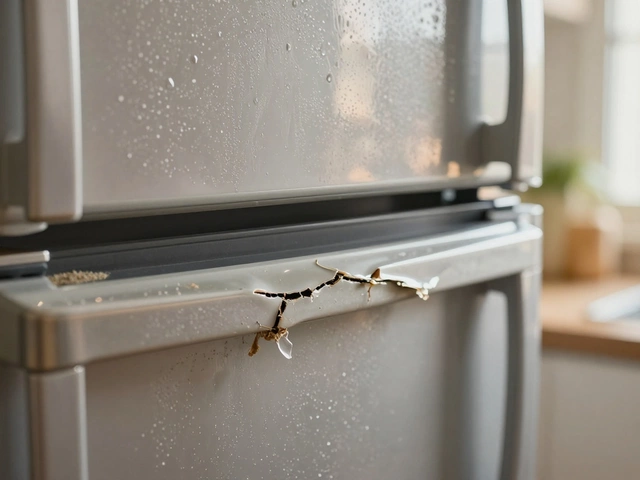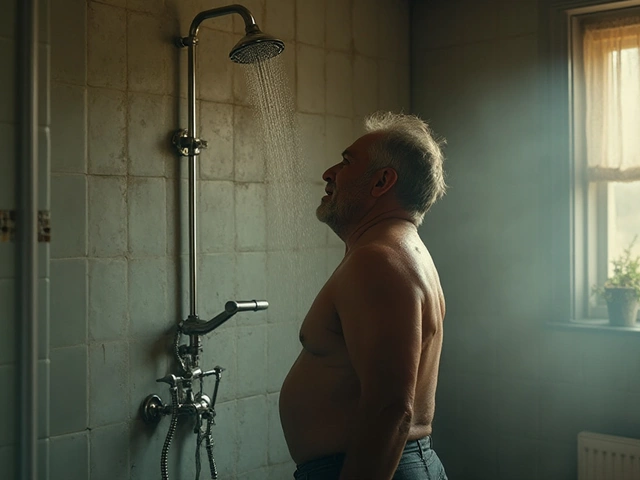Ever opened your fridge and found it warm inside while your ice cream has turned to soup? You're not alone. Fridges mess up for all kinds of reasons, and honestly, a lot of them aren’t that complicated. Sometimes, it's just a matter of a tripped breaker or a blocked vent. Other times, you might need to poke around a bit more—but you don’t always need to call in a repair guy right away.
If your fridge starts acting up, start with the basics. Check if it's still plugged in or if the outlet works—seriously, that's the main fix more often than you'd think. Give the back a quick once-over. Is the fan running, or is it dead quiet? Weird knocks, clicks, or hums can point you to the issue, too. Don't ignore spilled food or sticky gunk clinging to the rubber seals—this stuff can mess up the door seal and make the fridge work harder.
Before you decide to tackle repairs, keep your safety in check. Unplug the fridge before fiddling with anything inside. Wear gloves if you’re pulling off panels or backs. Most fridge fixes, like clearing a blocked drain hole or swapping a cracked shelf, aren't rocket science. You just need the right screwdriver, some patience, and a YouTube video or two. The key is knowing the difference between what you can handle and what should be left to someone in overalls with badges and tools for days.
- What Can Go Wrong (and Why Fridges Fail)
- DIY Fixes You Can Try Right Now
- When to Step Back and Call a Pro
- Tips to Keep Your Fridge Running Longer
What Can Go Wrong (and Why Fridges Fail)
Fridges aren’t complicated, but a few things almost always go wrong. Knowing what you’re dealing with is half the battle, especially when tackling fridge repair yourself. Most breakdowns come down to a handful of common issues. The number one culprit? Bad airflow. If your fridge is packed too tightly, cold air can’t move around—and stuff starts to spoil faster than you’d expect. Easy fix: move stuff around and keep vents clear.
Next up are dirty condenser coils. Those are the black or silver grid-like tubes on the back or bottom of your fridge. When they’re covered in dust or pet hair, your fridge works twice as hard just to keep things cool. Experts recommend cleaning these coils every six months, but few people actually do it.
Here’s a quick look at what typically goes wrong with refrigerators:
- Compressor issues: If the fridge is buzzing but not cooling, the compressor (the “engine” of your fridge) may be failing.
- Faulty thermostat: If temperatures are all over the place, the thermostat may be to blame.
- Broken door seals: Cracked or sticky seals let in warm air, forcing the fridge to overwork.
- Blocked defrost drain: Water can leak onto your floor or create chunks of ice if this little hole gets clogged.
- Broken fans: Both the condenser and evaporator fans are key players. If you stop hearing the normal whirring, check those first.
Water leaks are another headache and usually point to clogged drains or loose inlet tubes. Odd noises—clicks, hums, rattles—sometimes mean faulty start relays or fans that have seen better days.
| Common Issue | Signs | DIY Friendly? |
|---|---|---|
| Dirty Condenser Coils | Weak cooling, hotter kitchen | Yes |
| Broken Door Seal | Frost buildup, energy loss | Yes |
| Bad Compressor | No cooling, buzzing noise | No |
| Faulty Thermostat | Unstable temps | Sometimes |
Often, DIY fridge fix jobs are straightforward, especially when it comes to cleaning, minor part swaps, and basic troubleshooting. But if the repair has you prying into the guts of the fridge—think compressor or refrigerant leaks—it’s best to step back. Messing with those can void warranties or, worse, leave you with a totally dead appliance.
DIY Fixes You Can Try Right Now
Before you freak out and call for help, there’s a bunch of DIY fridge repair tricks you can try. Most of these don't need more than a screwdriver and a little confidence. Let's get straight to it:
- Check the power: This sounds obvious, but seriously—make sure the fridge is plugged in and the outlet is working. Flip the breaker if you need to.
- Clear the vents: Cold air needs room to move. If food is packed up against the vents, cooling will suck. Move stuff around so air can actually flow.
- Clean the coils: The coils underneath or behind the fridge collect dust and pet hair. When they get dirty, your fridge has to work harder. Unplug the fridge and use a vacuum or coil brush to get all that gunk off.
- Fix the seals: Stick a dollar bill in the fridge door and close it. If you can pull it out easily, you might need to clean or replace the gasket (the rubber seal). Clean it with warm, soapy water first—it often works wonders.
- Unblock the drain hole: Most fridges have a little drain hole at the bottom to get rid of condensation. If you see water puddling up, poke a pipe cleaner or straw gently into the drain hole to clear it out.
- Adjust the temperature settings: Sometimes someone accidentally bumps the dial. Check the temperature: you want your fridge set to about 37°F (3°C).
If your refrigerator troubleshooting leads to a noisy motor, try pulling the fridge out and making sure it’s level. Wobbly fridges can rattle like crazy. Adjust the little feet under the fridge until everything sits flat.
Here’s a quick-hit table with some common fridge repair issues and what usually fixes them:
| Problem | Easy Fix |
|---|---|
| Fridge isn't cold | Check power, clear vents, set right temp, clean coils |
| Water leaking inside | Unblock drain hole, check for spilled items |
| Fridge runs all the time | Clean coils, check seals, move fridge from wall slightly |
| Noise and rattling | Level the fridge, make sure it's not touching the wall |
Most home appliance repair jobs for your fridge start with these basics. Don’t overthink it. If none of these fixes help, or if you’re dealing with stuff like burnt smells or electrical shocks, step back and maybe call someone with pro gear and training.

When to Step Back and Call a Pro
There’s a point when trying to fix fridge yourself just isn’t worth the headache—or could even get dangerous. Not every issue can be tackled safely with a screwdriver and some internet advice, especially if you’re out of your comfort zone. Major problems like refrigerant leaks, electrical faults, or the compressor making disturbing noises scream for a licensed tech.
If you spot frost building up where it shouldn’t, or the freezer’s a sauna no matter what you try, that’s a red flag. Signs like water puddling under the fridge or the back panel running hotter than usual aren’t to be taken lightly. Messing with refrigerant lines or sealed system components (like the evaporator or condenser) is not a safe bet. It’s illegal in most places for unlicensed folks to handle refrigerants, and repairs gone wrong can make things worse—or turn pricey fast.
- Refrigerant leaks: Only a certified pro can recharge or repair these.
- Electrical problems: Tripping breakers, sparks, or burning smells need immediate pro help.
- Dead compressor: Replacement needs specialty parts and knowledge.
- Faulty control boards: Too complicated for standard DIY fixes.
According to a Consumer Reports survey in 2024, 78% of fridge owners who tried to fix complex parts like compressors or circuit boards themselves ended up needing a professional anyway, often at a higher cost.
| Problem | DIY Safe? | Needs a Pro? |
|---|---|---|
| Replacing a light bulb or door gasket | Yes | No |
| Fixing a clogged drain hole | Yes | No |
| Repairing a compressor | No | Yes |
| Refilling refrigerant | No | Yes |
| Replacing a main control board | No | Yes |
When you hit any of these walls, don’t poke around. You’ll just rack up costs or risk safety. That’s when it’s worth calling in someone who lives and breathes fridge repair for a living. Your appliance (and your wallet) will thank you later.
Tips to Keep Your Fridge Running Longer
Extending the life of your fridge doesn't take much high-level know-how—just a little common sense and routine care. Nearly half of fridge repair calls could be avoided with simple maintenance done a couple of times a year. Here’s what actually makes a difference.
- Clean the coils every 6 months: Dust and pet hair clog the coils (usually on the back or underneath). If the coils clog, your refrigerator works twice as hard and guzzles more electricity. Pop the grill off, use a coil brush or a vacuum, and you’re good.
- Check the door seals: A flimsy or dirty door seal lets cold air leak out, making your fridge struggle to keep cool. Run a dollar bill between the seal and the fridge—if it slips out easy, it’s time to clean or replace the seal.
- Don’t overload it: Cramming in too much food blocks the air vents, so cold air can’t flow right. That means uneven cooling and possible food spoilage.
- Keep it level: If your fridge tilts forward or back, the doors might not shut right. Use a basic level and adjust the feet until the fridge sits even. If the doors don’t seal, your motor works overtime and wears out early.
- Set the right temp: The sweet spot for most fridges is between 3°C and 5°C (37°F–41°F). Freezers should be at -18°C (0°F). Any colder, and you’re just wasting energy.
- Defrost the freezer (if manual): Ice build-up in manual defrost models means the freezer can’t move air, which hikes up your electric bill and shortens the fridge’s life. Don’t wait for an iceberg—defrost once ice is a quarter-inch thick.
Here’s a peek at just how much power simple fixes can save you:
| Maintenance Task | Potential Power Savings |
|---|---|
| Clean coils | Up to 15% lower energy use |
| Replace bad door seal | Up to 10% lower energy use |
| Defrost on time | 6% - 10% lower energy use |
Following these small steps doesn’t just boost your fridge’s lifespan—it helps you avoid hassle and keeps your food safer. A little attention, plus the right DIY fridge fix now and then, really pays off.







